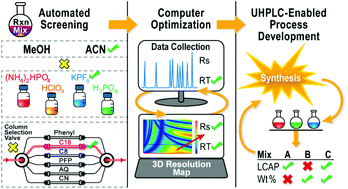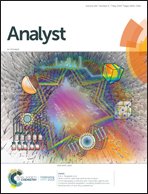Multi-column ultra-high performance liquid chromatography screening with chaotropic agents and computer-assisted separation modeling enables process development of new drug substances
Abstract
Modern process research and development can often be hampered by the tedious method development required to chromatographically resolve mixtures of chemical species with very similar physical properties. Herein, we describe a simple approach for the development and implementation of an efficient ultra-high performance liquid chromatography (UHPLC) assay that is extensively applied to the separation and analysis of multicomponent reaction mixtures of closely related pharmaceutical intermediates and impurities. Methods are optimized using multi-column and multi-solvent UHPLC screening in conjunction with chromatography simulation software (ACD Labs/LC Simulator). This approach is implemented to enable the separation, identification, mapping and control of impurities formed within the process chemistry optimization of the dimeric catalyst used in the synthesis of new drug substances. The final method utilized a sub-2 μm C18 stationary phase (2.1 mm I.D. × 50 mm length, 1.7 μm particle size ACQUITY UPLC BEH C18) with a non-conventional chaotropic mobile phase buffer (35 mM potassium hexafluorophosphate in 0.1% phosphoric acid/acetonitrile) in order to achieve baseline separation of all reaction components. The chromatographic simulation and modeling strategy served to generate 3D resolution maps with robust separation conditions that match the outcome of subsequent experimental data (overall ΔtR < 0.35%). Our multi-column UHPLC screening with computer-assisted chromatographic modeling is a great addition to the toolbox of synthetic chemists and can be a powerful tool for streamlining process chemistry optimization in organic chemistry laboratories across both academic and industrial sectors.



 Please wait while we load your content...
Please wait while we load your content...